 |
|

|
 |
TABLE of CONTENTS
 |
An exercise in problem solving: Hwy 71/Hwy 197 expansion project in Bemidji |
By Bob Filipczak
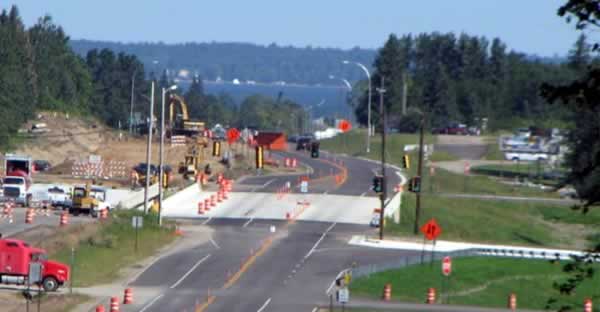
Adding a new bridge over Hwy 2 was one of the benefits of the Hwy 71/Hwy 197 project in Bemidji. The $24 million expansion project is expected to be completed by the end of October. Photo by Karen Bedeau |
The Hwy 71/Hwy 197 project in Bemidji seemed straightforward enough: a six-mile project expanding the highway from two lanes to four—five lanes in the city of Bemidji—and adding a new bridge over Hwy 2. It grew in complexity, explained Bill Pirkl, District 2/Bemidji traffic engineer, for a number of reasons:
- They had to redesign the whole project when the elementary school next to the highway changed its decision about access.
- They had to fit the new five-lane road under the Paul Bunyan trail.
- The project changed into a two-phase project in response to the school access issues.
- The government shutdown messed up the schedule, especially as it related to the school year.
- The project included both rural and urban areas.
Getting schooled
The most significant issue was a last-minute change by the school. Pirkl said that the original plan was to build a back access from a county road into the school, and MnDOT had already purchased the land to make that happen. However, the school decided it wanted direct access to Hwy 71. To accommodate the change, MnDOT created what Pirkl called a quasi-design build and split the project into two phases.
“Bill did a great job salvaging the project, especially the work already done in the first year,” said Phil Bergem, District 2/Bemidji design engineer, who worked on phase two.
Pirkl said the solution they came up with was a divided entry that increased safety by eliminating overlapping left turns into and out of the school property from Hwy 71. This required building a frontage road and relocating one of the school’s parking lots, but the result is drivers making a left into the school parking lot don’t compete with those making a left turn out of the lot, Pirkl said.
Monkey wrench
With a new two-phase schedule in hand, they were on target to have the new access in place before school began in the fall. Then the government shutdown happened.
“This is the project most affected by the shutdown for us. This is probably the trickiest and the one with the most impact for the citizens,” said Bergem.
Instead of having everything ready for the school year, the shutdown prevented the utilities from getting their work done on the right of way, and now the district has been forced to come up with a temporary access solution using Hwy 71’s shoulders for at least a month, said Pirkl. He is particularly sensitive to the safety issues around the school access because his kids go to school there.
With all of these hiccups, Pirkl was glad he had Larry Randall, project supervisor, on the job.
“Larry has had to button this project up throughout, and he is as good as it gets when it comes to construction engineers, so it’s in good hands. He was able to overcome all the surprises,” Pirkl said.
Randall anticipates that the project will be complete near the end of October.
“We hope so,” he said. “Of course, with the government shutdown, that threw a monkey wrench into everything.”
Randall has been working hard to get everything back up and running with the contractor and getting the work back on schedule.
“I’ve never had a project yet where we didn’t run into surprises,” said Randall. “And this one was the same.”
|
 |
|

|
 |
TABLE of CONTENTS
 |
Minnesota receives $7.2 million in grants from FHWA for highway projects |
By Jessica Wiens
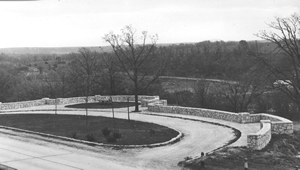
The Historic Bluff County Scenic Byway Preston Overlook was constructed in the 1930s and will be restored using a $787,000 grant from the FHWA and additional funds from District 6. Photo from MnDOT archives
|
Minnesota received more than $7.2 million in grants from the Federal Highway Administration to help fund 10 highway-related projects across the state.
These grants will help improve the quality of life and economic development of many communities in the state, according to Scott Peterson, Government Affairs director.
The largest award in Minnesota was a $2 million grant to accelerate replacement of the Interstate 35E/Maryland Avenue Bridge in St. Paul.
The Hwy 4 reconstruction project through Cosmos was also partially funded. The District 8 project includes removing and replacing pavement, narrowing the roadway, making sidewalk and pedestrian improvements, and improving ADA accessibility. It is tentatively scheduled for summer 2013.
“We are extremely excited to receive this grant,” said Susann Karnowski, District 8 program and project development engineer. “The total project cost estimate is $4.625 million, so our next step is to figure out how to bridge the gap and get this project going.”
The Minnesota Scenic Byways Program received more than $2.3 million for five projects. One of those projects is to restore the Preston Overlook near Hwy 16/Hwy 52 in District 6. This site is on the National Register of Historic Places. Crews will restore the stone wall, plantings and plaza walkways in summer 2012.
“Historic properties can easily be lost if not properly restored,” said Kathryn McFadden, project manager. “We could never build this site again. Now, it’s going to be saved.”\
In previous years, Congress designated some of this grant money for specific projects and FHWA awarded the remainder through a competitive process. Because the FY11 budget passed by Congress last April directed that all such funds be discretionary, FHWA awarded these funds entirely through a competitive process.
More than 1,800 applications were submitted in June for federal funding from 14 grant programs. Requests poured in from every state and the applications totaled nearly $13 billion, which is more than 30 times the funds available.
Minnesota projects
|
Award |
- Replace bridge at I-35E/Maryland Avenue Interchange in St. Paul
|
$2,040,000 |
- Reconstruct Hwy 4 in the city of Cosmos
|
$1,956,601 |
- Rehabilitate Skyline Parkway State Scenic Byways Historic Stewart Creek Bridge
|
$800,000 |
- Restore stone wall, plantings and plaza walkways in the Historic Bluff County Scenic Byway Preston Overlook Restoration Project
|
$787,516 |
- Evaluate ways to address livability as part of the Minnesota-Mississippi River Parkway Commission’s work
|
$560,000 |
- Assist with growth and development of 250 underutilized disadvantaged business enterprises
|
$407,400 |
- Lay precast and high-performance concrete on Hwy 36 Bridge over Keller Lake in Ramsey County
|
$265,000 |
- Provide employment support services for highway related activities
|
$250,000 |
- Update and expand the Minnesota River Valley Scenic Byway Corridor Management Plan
|
$119,712 |
- Make Americans with Disabilities Act accessibility improvements to North Shore Scenic Drive
|
$50,000 |
TOTAL
|
$7,236,229 |
|
 |
|

|
 |
TABLE of CONTENTS
 |
New state highway map features more than location information |
By Libby Schultz
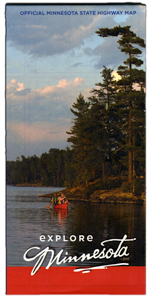
Free highway maps will be given out at the MnDOT booth in the Education Building at the Minnesota State Fair. Maps also can be found at travel information centers, the MnDOT map sales office and the Department of Administration. |
MnDOT recently released the new 2011-2012 Minnesota State Highway Map, which features the state’s extensive highway system, as well as location and information on state parks, state historic sites, state bicycle trails and scenic byway routes.
The map, the department’s most popular publication, is produced by the Geographic Information and Mapping Section in the Office of Transportation Data and Analysis.
There are brand new “get active Minnesota” photos and ideas including biking, rock climbing, hiking, winter fun and more.
“Minnesota is so vast and beautiful,” said Jeff Saholt, Geographic Information and Mapping Section director. “It offers so many fascinating destinations that can be discovered on the new map.”
Free highway maps will be given out at the MnDOT booth in the Education Building at the Minnesota State Fair. Maps also can be found at travel information centers, the MnDOT map sales office and the Department of Administration. To view the new online version of the map, visit www.dot.state.mn.us/statemap/.
The official state highway map is produced and published jointly by MnDOT, Explore Minnesota Tourism and the Department of Administration. For questions about the new state highway map, contact Jeff Saholt at 651-366-3885. |
 |
|

|
 |
TABLE of CONTENTS
 |
Safety initiatives headline MnDOT's State Fair exhibit |
|
By Lisa Yang
The 2011 Minnesota State Fair opens Aug. 25, and MnDOT is again participating in the Great Minnesota Get Together.
About 100 MnDOT employees will be staffing the exhibit in the Education Building and handing out state highway maps to visitors.
“Every year, we hand out more than 30,000 state highway maps at the fair,” Deputy Commissioner Bernie Arseneau said. “It’s the most popular thing visitors seek at the MnDOT exhibit.”
This year, MnDOT’s exhibit focuses on safety initiatives under the theme of “Your Destination…Our Priority.” Some of the main topics featured in the exhibit are roundabouts, the zipper merge, Smart Lanes, diverging diamond interchange, and the flashing yellow arrow.
“The fair is one of the best ways that our agency can connect with the public,” Arseneau said. “It’s another opportunity to hear from them and talk with them about improving transportation in Minnesota.”
A few shifts remain for employees who want to work at the MnDOT exhibit. Go to http://ihub/statefair/ for information on how to sign up.

MnDOT’s exhibit features an operating flashing yellow arrow traffic signal and a touchscreen kiosk that displays information about roundbabouts, the zipper merge, Smart Lanes, and other traffic-related technology.
|
|
 |
|

|
 |
TABLE of CONTENTS
 |
District 7's Rich Bruegger eligible for vacation donation |
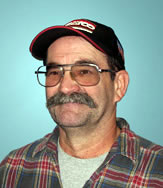
Rich Bruegger, District 7/Wells Truck Station, is now eligible for the state vacation donation program. He has used up his sick and vacation hours caring for his gravely ill wife. Photo courtesy of District 7 |
Rich Bruegger, District 7/Wells Truck Station, is now eligible for the state vacation donation program, which allows employees to donate up to 40 hours of vacation per fiscal year for approved recipients who have exhausted their sick and vacation leave due to illness.
Bruegger’s wife, Cindy, was diagnosed with cancer in August 2010. As Cindy continues to battle cancer, Bruegger will use the donated vacation hours to provide the round-the-clock care Cindy requires.
To donate vacation hours, go to the Employee Self Service Web site and click “Other Payroll” and then “Leave Donations.” The site also allows employees to view a list of all state employees eligible for the program and enroll as a recipient.
Related information:
Road to recovery: Vacation donation program eases the pain (Newsline, Nov. 10, 2010)—Read a viewpoint from one Mn/DOT recipient.
|
 |
|

|
 |
TABLE of CONTENTS
 |
Regensheid appointed new District 7 assistant district engineer |
By Libby Schultz

Gordy Regenscheid is District 7's new assistant district engineer for State Aid/Planning, effective Aug. 29. Photo courtesy of District 7 |
Gordy Regensheid will replace Douglas Haeder as assistant district engineer for State Aid/Planning for District 7. Haeder retired June 30.
Regensheid was District 7’s assistant district engineer for Highway Maintenance Operations since November 2000, and will be moving to his new position on Aug. 29.
Before coming to MnDOT, Regensheid was the Meeker County Engineer for more than 17 years, and worked as a civil engineer for the Clay County Highway Department for eight years.
Regensheid has a Bachelor of Science in Civil Engineering from North Dakota State University.
“I am fortunate to inherit a work area that is well organized and functioning at a high level,” Regensheid said.
His goal in his new position is to “utilize [his] abilities and experience to provide direction and further develop areas such as ADA, snow and ice techniques and safety initiatives” within District 7.
|
 |
|

|
 |
TABLE of CONTENTS
 |
New training registration process begins: "Cone Man" retires |
By Lucy Kender, Office of Human Resources MnDOT transitioned to the new statewide Enterprise Learning Management system for training registration and records July 1—just as the shutdown began, so employees are now just one month into using the new system.
“Some are finding the new system a bit challenging, but as with any technological change it takes getting used to new processes and ways of doing things,” said Patti Follmer, ELM system administrator, Office of Human Resources.
Follmer works directly with employee development specialists and other training staff to train them on the new system and provide trouble-shooting as needed. She recommends checking with your training representative if you need assistance with the new system.
New registration website, link
With the old learning system, many employees used a desktop icon known as “Cone Man” for direct access to MnDOT’s learning center and additional training information. Along with the many other recent retirements at MnDOT, the Cone Man icon will retire soon as well.
In its place, a new link under the iHUB “Your Career” button called “Register for Training” takes you to a web page with details on how to register. You can also find listings in the iHUB “A-Z” that can link you to the site, Follmer said.
Follmer recommends saving the page in your favorites or creating your own desktop shortcut if you use the site regularly.
Training records
“We’ve only been able to transition a small sample of employee training records to the new system so far. We expect all records with a ‘completed’ status to transfer by late fall,” said Follmer.
Contact your training representative or Patti Follmer if you need of a copy of your previous training transcript.
Check the iHUB Training Registration, Records and Resources website for further updates, information and training aids.
|
 |
|

|
 |
TABLE of CONTENTS
 |
Diversity Council hosts African Leaders in Transportation brown bag event |
By Jessica Wiens
The Diversity Council invites all MnDOT employees to participate in the African Leaders in Transportation brown bag event Wednesday, Aug. 31, from noon to 1 p.m.
Speakers will discuss the vastness of African countries and cultures and look into transportation and current events in Africa. Some MnDOT employees will also share aspects of their culture and how it is different from or similar to U.S. national culture.
“Every employee has an interesting story to tell. This is a great opportunity for participants to learn something new about our co-workers from Africa,” said Stephany Osuji, Customer Relations and planning committee member.
Employees can participate in person at Central Office rooms G13-G14 or via Adobe Connect.
Instructions for joining the event via Adobe Connect are available at ihub.dot.state.mn.us/diversity/. |
 |
|

|
 |
TABLE of CONTENTS
 |
New bridge inventory system up and running |
By Becky Dahlberg
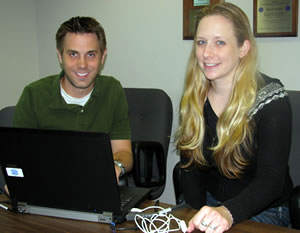
SIMS technical experts David Hedeen and Jennifer Zink, Bridge Office, lead training sessions for inspectors statewide. Photo by Becky Dahlberg |
The Bridge Office unveiled a new bridge inventory database in May called Structure Information Management System. SIMS is used to store bridge inspection data, and allows bridge inspectors to manage critical records such as structure information, ratings, inspection reports, photos and more in one unified system. Newsline spoke recently with David Hedeen, SIMS project team member, and Jennifer Zink, bridge inspection engineer and SIMS inspection technical expert, to get the scoop on the new system.
How does SIMS work?
Bridge inspectors log into SIMS with a controlled username and password. Once logged into the system, the inspector can create a new inspection report, modify an existing report, upload new photos, etc. Unlike its predecessor database, Pontis, SIMS is web-based so inspectors out in the field can enter bridge information on their laptops from any location that has an Internet connection.
The system also has a built-in audit process that tracks exactly who entered the inspection data, if and when it was approved, whether there were any changes, and when those changes were made. Future enhancements to SIMS include bridge maintenance prioritization and scheduling, inspection data capabilities for other structure types, and inter-communication with other MnDOT programs.

Inspectors can pull up a street view of any state bridge using the SIMS mapping feature. |
Why is a structure information management system needed?
The idea of a total bridge management and inspection system was initiated in early 2008 after the Interstate 35W bridge collapse on Aug. 1, 2007. Previously, bridge information was in various locations such as the Bridge Office, district office file cabinets and shared network drives. It took a lot of time and effort to locate all information related to one bridge. With SIMS, however, an inspector or bridge manager can log into his or her account and view all known bridge data on any bridge in their jurisdiction.
Where can I learn more about SIMS?
SIMS was developed by InspectTech, a company that provides customized inspection software applications. For more information on SIMS and its development, visit www.mndot.gov/bridge/sims.
|
 |
|

|
 |
TABLE of CONTENTS
 |
Innovative idea becomes valuable training opportunity in District 1 |
By Beth Petrowske, District 1 Public Affairs

Firefighters and other emergency responders participated Aug. 8 in an exercise on the Blatnik Bridge in Duluth to practice rescuing stranded or injured bridge workers. Photo courtesy of Lakes Superior College |
The Interstate 535/Hwy 53 Blatnik Bridge in Duluth served as a training ground Aug. 8, as firefighters and other emergency responders participated in an exercise aimed at helping them practice techniques to rescue stranded or injured bridge workers.
Carol Brotski, District 1 Safety Administrator, got the idea to plan the bridge rescue training exercise in late July. After many hours of planning and networking, the idea became reality.
The Duluth Fire Department tested three rescue methods that could be employed in real emergencies. Many participants commented during an after-exercise debriefing that the training was extremely beneficial.
"You can train all you want but to actually get out there and do it," said Jeremy Helm Duluth firefighter, "I know I can do it in a real situation."
John Cavanaugh, District 1 employee development specialist, added to the success of the exercise by bringing his knowledge in emergency planning through his homeland security background.
Gary Andrist, MnDOT videographer, was on hand to capture the event and conduct interviews with the participants. The video will assist other MnDOT districts and their local emergency response personnel in their bridge rescue planning.
Partners in the training exercise include MnDOT, the Duluth Fire Department, First Strike Safety, Lakes Superior College, Aspen Aerials (Duluth manufacturer of snooper vehicles), WISDOT, the Superior Fire Department and a local towing company. |
 |
|
| |
|



